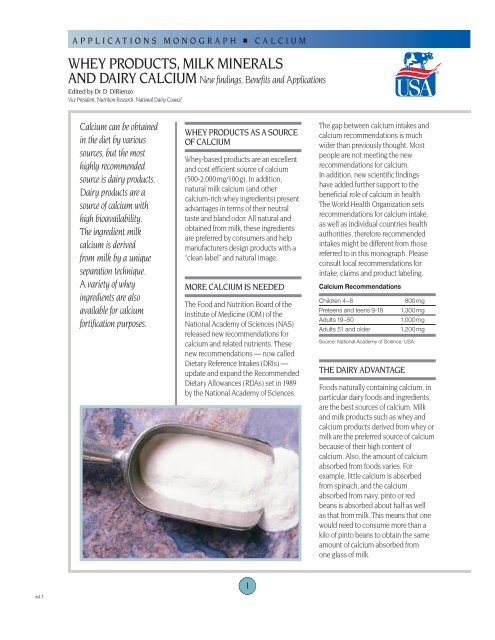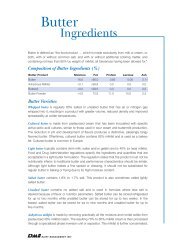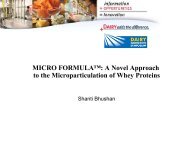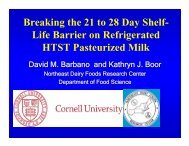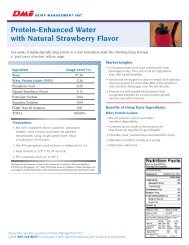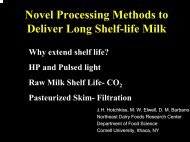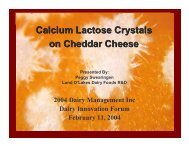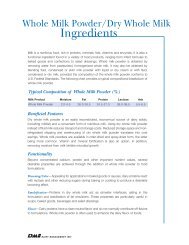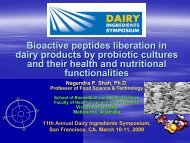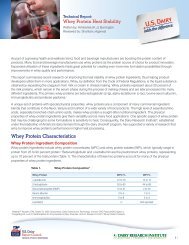Whey products, milk minerals and dairy calcium - InnovateWithDairy ...
Whey products, milk minerals and dairy calcium - InnovateWithDairy ...
Whey products, milk minerals and dairy calcium - InnovateWithDairy ...
Create successful ePaper yourself
Turn your PDF publications into a flip-book with our unique Google optimized e-Paper software.
APPLICATIONS MONOGRAPH ■ CALCIUMWHEY PRODUCTS, MILK MINERALSAND DAIRY CALCIUM New findings, Benefits <strong>and</strong> ApplicationsEdited by Dr. D. DiRienzoVice President, Nutrition Research, National Dairy CouncilCalcium can be obtainedin the diet by varioussources, but the mosthighly recommendedsource is <strong>dairy</strong> <strong>products</strong>.Dairy <strong>products</strong> are asource of <strong>calcium</strong> withhigh bioavailability.The ingredient <strong>milk</strong><strong>calcium</strong> is derivedfrom <strong>milk</strong> by a uniqueseparation technique.A variety of wheyingredients are alsoavailable for <strong>calcium</strong>fortification purposes.WHEY PRODUCTS AS A SOURCEOF CALCIUM<strong>Whey</strong>-based <strong>products</strong> are an excellent<strong>and</strong> cost efficient source of <strong>calcium</strong>(500-2,000mg/100g). In addition,natural <strong>milk</strong> <strong>calcium</strong> (<strong>and</strong> other<strong>calcium</strong>-rich whey ingredients) presentadvantages in terms of their neutraltaste <strong>and</strong> bl<strong>and</strong> odor. All natural <strong>and</strong>obtained from <strong>milk</strong>, these ingredientsare preferred by consumers <strong>and</strong> helpmanufacturers design <strong>products</strong> with a“clean label” <strong>and</strong> natural image.MORE CALCIUM IS NEEDEDThe Food <strong>and</strong> Nutrition Board of theInstitute of Medicine (IOM) of theNational Academy of Sciences (NAS)released new recommendations for<strong>calcium</strong> <strong>and</strong> related nutrients. Thesenew recommendations — now calledDietary Reference Intakes (DRIs) —update <strong>and</strong> exp<strong>and</strong> the RecommendedDietary Allowances (RDAs) set in 1989by the National Academy of Sciences.The gap between <strong>calcium</strong> intakes <strong>and</strong><strong>calcium</strong> recommendations is muchwider than previously thought. Mostpeople are not meeting the newrecommendations for <strong>calcium</strong>.In addition, new scientific findingshave added further support to thebeneficial role of <strong>calcium</strong> in health.The World Health Organization setsrecommendations for <strong>calcium</strong> intake,as well as individual countries healthauthorities, therefore recommendedintakes might be different from thosereferred to in this monograph. Pleaseconsult local recommendations forintake, claims <strong>and</strong> product labeling.Calcium RecommendationsChildren 4–8Preteens <strong>and</strong> teens 9-18Adults 19–50Adults 51 <strong>and</strong> older800mg1,300mg1,000mg1,200mgSource: National Academy of Science. USA.THE DAIRY ADVANTAGEFoods naturally containing <strong>calcium</strong>, inparticular <strong>dairy</strong> foods <strong>and</strong> ingredients,are the best sources of <strong>calcium</strong>. Milk<strong>and</strong> <strong>milk</strong> <strong>products</strong> such as whey <strong>and</strong><strong>calcium</strong> <strong>products</strong> derived from whey or<strong>milk</strong> are the preferred source of <strong>calcium</strong>because of their high content of<strong>calcium</strong>. Also, the amount of <strong>calcium</strong>absorbed from foods varies. Forexample, little <strong>calcium</strong> is absorbedfrom spinach, <strong>and</strong> the <strong>calcium</strong>absorbed from navy, pinto or redbeans is absorbed about half as wellas that from <strong>milk</strong>. This means that onewould need to consume more than akilo of pinto beans to obtain the sameamount of <strong>calcium</strong> absorbed fromone glass of <strong>milk</strong>.1eJ.1
APPLICATIONS MONOGRAPH ■ CALCIUMMAJOR FUNCTIONS OF CALCIUM IN THE BODYCALCIUM’S ROLEIN BONE DEVELOPMENTBones serve as a basic support systemprotecting vital organs <strong>and</strong> as a reservoir for<strong>calcium</strong> — the most abundant mineral inthe body. In fact, 99% of the body’s <strong>calcium</strong>is found in bones <strong>and</strong> teeth (the other 1% isfound in cells, blood, <strong>and</strong> other body fluids).Despite its static appearance, bone isconstantly being formed <strong>and</strong> broken down.This process, called remodeling, is theresorption (breaking down) of existing bone<strong>and</strong> deposition of new bone to replace thatwhich has been broken down. At any onetime, about 10% to 15% of bone surfacesare undergoing remodeling. A numberof interrelated hormonal, nutritional,mechanical, <strong>and</strong> genetic factorsinfluence remodeling.Resorption of old bone <strong>and</strong> formation ofnew bone are processes that continuouslyoverlap. The importance of these processesvaries at different times throughout the lifecycle. In general, from birth until aboutage 20, the bones are in a phase of activegrowth. Beginning in the 40s or later,resorption of existing bone starts to exceedformation of new bone, resulting in a netloss. Age-related bone loss is influenced byboth genetic <strong>and</strong> environmental factors.The body’s <strong>calcium</strong> status depends more onoverall nutritional factors than just <strong>calcium</strong>intake. Some nutritive factors influence thebody’s absorption of <strong>calcium</strong>, while otherfactors affect <strong>calcium</strong> retention or urinary<strong>calcium</strong> excretion. Urinary losses of <strong>calcium</strong>are a big determinant of <strong>calcium</strong> loss.Calcium nutriture depends not only on<strong>calcium</strong> intake, but also on numerousdietary <strong>and</strong> nondietary factors that influence<strong>calcium</strong> metabolism. Dietary factors aiding<strong>calcium</strong> absorption <strong>and</strong> retention include:vitamin D, lactose (which stimulatesthe intestinal absorption of <strong>calcium</strong> inlaboratory animals <strong>and</strong> in human infants),fructo-oligosaccharides, phosphorus,protein, sodium <strong>and</strong> other elements.BEYOND BONESCalcium also is important for thedevelopment of teeth. Teeth, like bones,are calcified tissue. The teeth begin to formin the first few months of fetal life <strong>and</strong> themineralization process continues into lateadolescence. An adequate intake of <strong>calcium</strong>,in addition to phosphorus, protein, fluoride,<strong>and</strong> vitamins A, C, <strong>and</strong> D, is needed forproper development of tooth structures.Although the mature tooth is metabolicallyactive, the fully eruptive adult tooth is notsignificantly subject to resorption.Outside of bones <strong>and</strong> teeth, the level ofionized <strong>calcium</strong> in the blood must bemaintained within a narrow range toperform <strong>calcium</strong>’s regulatory functions.When the diet is low in <strong>calcium</strong>, thebones release enough <strong>calcium</strong> into thebloodstream to meet the body’s needs.Although the amount of <strong>calcium</strong> outsidebones <strong>and</strong> teeth is relatively small, it isrequired for a number of basic regulatoryfunctions including:• Contraction <strong>and</strong> relaxation of muscle(including normal heart beat)• Coagulation of blood• Transmission of nerve impulses• Activation of enzyme reactions• Stimulation of hormone secretions• Integrity of intracellularcement substancesCalcium for Mature Adults51 <strong>and</strong> OlderEverybody needs <strong>calcium</strong>. But withage, one needs more to offset <strong>calcium</strong>losses from bone <strong>and</strong> decreased<strong>calcium</strong> absorption. Individuals 51or over need 1,200mg of <strong>calcium</strong>a day. Though <strong>calcium</strong> can be foundin a variety of foods, leading healthexperts recommend <strong>milk</strong> <strong>and</strong> <strong>milk</strong><strong>products</strong> as the preferred sourcesof <strong>calcium</strong>.2eJ.2
APPLICATIONS MONOGRAPH ■ CALCIUMFOUR GOOD REASONSTO COUNT ON CALCIUMWhile there are no magic bullets or miraclecures, researchers are finding that somenutrients such as <strong>calcium</strong> can play a majorrole in disease prevention. Appropriate <strong>dairy</strong>consumption <strong>and</strong> <strong>calcium</strong> intake may helpreduce the risk of:• Osteoporosis• High Blood Pressure• Colon Cancer• Cardiovascular DiseaseCALCIUM AND CHRONICDISEASE PREVENTIONIncreasing scientific evidence indicates thatan adequate <strong>calcium</strong> intake may help reducethe risk of several major chronic diseasesincluding osteoporosis, hypertension, coloncancer, <strong>and</strong> possibly cardiovascular disease<strong>and</strong> kidney stones. These diseases areresponsible for considerable morbidity<strong>and</strong> mortality in many patients, as well asrising national health expenditures.OSTEOPOROSISOne out of two women <strong>and</strong> one out of eightmen will develop osteoporosis. A diet highin <strong>calcium</strong> can help slow bone loss.Osteoporosis (porous bones) is a skeletaldisease in which bones become so fragilethey spontaneously break as a resultof a minor fall or even from everydayactivities. Decreased bone mass <strong>and</strong>microarchitectural damage to bone tissuecause the bones to become fragile.The rate of osteoporosis has reachedepidemic proportions in many countriesof the world <strong>and</strong> is responsible forconsiderable morbidity, mortality,<strong>and</strong> economic costs.Diet, specifically <strong>calcium</strong> intakes below therecommended levels throughout life, mayincrease the risk of osteoporosis. Also, aninadequate vitamin D status contributesto low bone mass. Ensuring an adequate<strong>calcium</strong> <strong>and</strong> vitamin D status throughout lifeis estimated to reduce osteoporotic fracturerisk by 50% or more. Other dietary factorslike sodium, protein, <strong>and</strong> fiber may influencethe risk of osteoporosis by impacting<strong>calcium</strong> status. However, if <strong>calcium</strong> intakeis adequate, these other dietary factors haverelatively little effect on osteoporosis risk.Osteoporosis experts agree that an optimalintake of <strong>calcium</strong> throughout life, from earlychildhood <strong>and</strong> adolescence through thepostmenopausal <strong>and</strong> later adult years,reduces the risk of osteoporosis. Researchindicates that it is never too early or too lateto improve bone health <strong>and</strong> reduce the riskof osteoporosis. Intake of <strong>milk</strong> <strong>and</strong> <strong>milk</strong><strong>products</strong> has been demonstrated to protectagainst osteoporosis by increasing boneretention <strong>and</strong> reducing fractures.In a study involving over 5,500 women50 years of age <strong>and</strong> older from six countries,an adequate <strong>calcium</strong> intake from <strong>milk</strong>decreased the number of hip fracturesby 35%.eJ.33
APPLICATIONS MONOGRAPH ■ CALCIUMHYPERTENSIONAs many as 50 million Americans <strong>and</strong> manymillions in other countries have high bloodpressure (hypertension), which increasesthe risk of heart disease, stroke, <strong>and</strong>kidney disease.In the U.S. the Joint National Committeeon Direction, Evaluation <strong>and</strong> Treatmentof High Blood Pressure recommendsconsuming adequate amounts of <strong>calcium</strong>(as well as potassium <strong>and</strong> magnesium) tohelp reduce blood pressure. A review of 25epidemiological studies investigating therelationship between the intake of <strong>calcium</strong>or <strong>calcium</strong>-rich foods <strong>and</strong> blood pressurefound that the majority of these studiessupported an inverse relationship. Thebeneficial effect of <strong>calcium</strong> on bloodpressure provides yet another reason toensure adequate intake of <strong>calcium</strong>-richfoods as part of a healthy diet. An advantageof <strong>milk</strong> <strong>minerals</strong> (as an ingredient forenrichment) over other <strong>calcium</strong> sources,is that this ingredient provides highlybioavailable <strong>calcium</strong> in balance with other<strong>minerals</strong> to optimize health benefits.A diet containing an adequate amountof <strong>calcium</strong> is recommended as anonpharmacological lifestyle modificationfor the prevention <strong>and</strong> treatment of highblood pressure. Many studies havedemonstrated that <strong>calcium</strong> reducesthe risk of hypertension or high bloodpressure, especially in certain subgroupsof the population.Since the early 1980s, scientific research hasshown that <strong>calcium</strong> plays an important rolein regulating blood pressure. Findings fromnumerous population studies, experimentalanimal investigations, <strong>and</strong> clinical trialsindicate that increasing <strong>calcium</strong> intakelowers blood pressure or reduces the riskof hypertension. In population studies,people with high blood pressure havelower intakes of <strong>calcium</strong> than people withnormal blood pressure, <strong>and</strong> vice versa.In humans <strong>and</strong> experimental animalswith hypertension, abnormalities in<strong>calcium</strong> metabolism have been detected.In clinical trials of <strong>calcium</strong> supplementation,blood pressure is reduced in manyindividuals, particularly those at highrisk of hypertension <strong>and</strong>/or who haveinadequate <strong>calcium</strong> intakes.Although increased <strong>calcium</strong> intake generallylowers blood pressure more in adults thanin children, a blood-pressure-lowering effectof <strong>calcium</strong> has been demonstrated in someyoung children, especially those whose<strong>calcium</strong> intakes are initially low. In teens,differences in <strong>calcium</strong> intake have beenobserved between those with high-normal<strong>and</strong> low-normal blood pressure (82).Because as many as one half of childrenwith high blood pressure may havehypertension as adults’ (83), childrenshould consume an adequate intakeof <strong>calcium</strong>.Coronary heart disease (CHD) is themost common <strong>and</strong> serious form ofcardiovascular disease in the United States.Cigarette smoking, high blood pressure(hypertension), <strong>and</strong> elevated bloodcholesterol levels are the major risk factorsfor this disease. Calcium may protectagainst CHD by its effect on two of theserisk factors: hypertension <strong>and</strong> blood lipidlevels. In patients with mild to moderatehypercholesterolemia, an increased <strong>calcium</strong>intake lowers total <strong>and</strong> LDL (low-densitylipoprotein) blood cholesterol levels.Calcium alone is not responsible for <strong>milk</strong>’sprotective effect against stroke. Total<strong>calcium</strong> intake or intake of <strong>calcium</strong> fromnon<strong>dairy</strong> sources did not have thesame protective effect as <strong>milk</strong>.Taking the Pressure Off:The Calcium ConnectionSome studies suggest that cutting backon salt lowers the risk of high bloodpressure. However, new researchshows that increasing <strong>calcium</strong>consumption to at least recommendedlevels (1,000mg/day for adults 19-50<strong>and</strong>1,200mg/day for adults 51 <strong>and</strong>older) is also associated with a small,but important, reduction in bloodpressure. This effect is expected to beeven greater in people at high risk forboth hypertension <strong>and</strong> low <strong>calcium</strong>intakes including African Americans<strong>and</strong> mature adults (ages 51+).Calcium has two “partners” that helpcurb high blood pressure — potassium<strong>and</strong> magnesium. They pitch in to helpkeep blood pressure levels in check.Luckily, <strong>milk</strong> <strong>products</strong> <strong>and</strong> ingredientssuch as <strong>milk</strong> <strong>minerals</strong> contain ampleamounts of all three.4eJ.4
APPLICATIONS MONOGRAPH ■ CALCIUMCALCIUM AND WEIGHT LOSSBy Dr. M. B. ZemelDepartment of Nutrition, University of TennesseeCOLON CANCERExperimental animal <strong>and</strong> human evidencesupports the hypothesis that <strong>calcium</strong> intakeinversely correlates with colon cancer risk<strong>and</strong> cell proliferation in the colonic mucosa.Colon cancer is the third leading causeof cancer deaths in the United States<strong>and</strong> a leading cause in many countries.Both genetics <strong>and</strong> environmental factorscontribute to this disease. While somedietary factors are suspected of contributingto colon cancer, others are thought to beprotective. Several components in cow’s<strong>milk</strong> fat such as conjugated linoleic acid,sphingolipids, <strong>and</strong> butyric acid have beenfound to protect against colon cancer inexperimental animal <strong>and</strong> laboratory studies.Findings from a number of scientific studiesindicate that <strong>calcium</strong> intakes in excess ofcurrent recommendations may reduce therisk of colon cancer.Studies to date indicate that <strong>calcium</strong> intakeof 1,500 to 2,000mg/day — amounts greaterthan current <strong>calcium</strong> recommendations of1,000 to 1,200mg/day for most adults —are necessary to protect against coloncancer, especially in individuals at risk ofthis disease. However, further studiesare needed to firmly establish <strong>calcium</strong>’sprotective effect against colon cancer <strong>and</strong>to determine the mechanism(s) involved.Advice to increase <strong>calcium</strong> intake abovecurrent recommendations to protect againstcancer is considered premature at this time.Dietary <strong>calcium</strong> plays a pivotalrole in the regulation of energymetabolism as has been foundthrough studies evaluating <strong>dairy</strong><strong>calcium</strong> in weight loss diets.High <strong>dairy</strong> <strong>calcium</strong> diets havebeen shown to attenuateadipocyte lipid accretion <strong>and</strong>weight gain during periodsof over-consumption of anenergy-dense, <strong>and</strong> to increaselipolysis <strong>and</strong> preservethermogenesis during caloricrestriction, thereby acceleratingweight loss.Studies of the agouti geneconducted at the University ofTennessee Department of Nutritionin obesity <strong>and</strong> insulin resistancedemonstrate a key role forintracellular Ca 2+ in regulatingadipocyte lipid metabolism <strong>and</strong>triglyceride storage with increasedintracellular Ca, resulting instimulation of lipogenic geneexpression <strong>and</strong> lipogenesis <strong>and</strong>suppression of lypolysis. High<strong>calcium</strong> diets apparently inhibitlipogenesis, markedly accelerate fatloss <strong>and</strong> suppress fat accretion inanimals maintained at identicalcaloric intakes. These findings arefurther supported by clinical datademonstrating that increased dietary<strong>calcium</strong> (as obtained in whey in<strong>milk</strong> <strong>products</strong>) results in significantreduction in fat tissue mass inobese humans.Notably, <strong>dairy</strong> sources of <strong>calcium</strong>(such as <strong>calcium</strong> from <strong>dairy</strong> <strong>products</strong>)exert a significantly greater antiobesityeffect than supplementalsources in epidemiological studies,indicating an important role for <strong>dairy</strong><strong>products</strong> in the control of obesity.eJ.5High Calcium Caramel C<strong>and</strong>yIngredientsPercentGranulated Sugar (sucrose) 34.8042 D.E. Corn Syrup 33.50Partially Hydrogenated Coconut Oil (92°F) 11.80Water 5.90Skim Milk Powder (SMP) 4.20WPC-34 4.20Butter 3.00Milk Minerals 2.30Vanilla Extract 0.10Soy Lecithin 0.10Salt 0.10Totals 100.00Formula courtesy of Dairy Mangement Inc.Procedure1. Pre-hydrate WPC-34 <strong>and</strong> SMPseparately with water to make a 30%solution <strong>and</strong> let sit overnight.2. Mix sugar, corn syrup <strong>and</strong> watertogether <strong>and</strong> dissolve over heat.3. Add remainder of ingredients.4. Mix all ingredients under low heat(mix thoroughly).5. Increase heat <strong>and</strong> boil to 242°F (116°C).6. Transfer to cold table.7. Cool <strong>and</strong> cut.5
APPLICATIONS MONOGRAPH ■ CALCIUMBUILDING AND MAINTAINING STRONG BONES:A Case for Balance in Dietary Mineral ConsumptionDr. Eric BastianDirector Research <strong>and</strong> Development, Glanbia Foods Inc.Recently, the importance of dietary<strong>calcium</strong> has increased becauseresearch has established that<strong>calcium</strong> is not only essential forbone growth <strong>and</strong> development,it is important for regulation of cellfunction, nerve conduction, musclecontraction, <strong>and</strong> blood coagulation.In addition, <strong>calcium</strong>provides a protective role againstosteoporosis, essential hypertension,gestational hypertension,hypercholesterolemia, certaincancers (colon <strong>and</strong> mammary)<strong>and</strong> possibly gallstones.Several population segments in bothdeveloped <strong>and</strong> developing countrieshave low <strong>calcium</strong> intake. Calciumsupplementation <strong>and</strong> fortificationhas become increasingly important<strong>and</strong> <strong>calcium</strong> is being incorporatedinto many food <strong>products</strong> aroundthe world. Calcium supplementsare usually <strong>calcium</strong> salts suchas <strong>calcium</strong> citrate, <strong>calcium</strong>lactate, <strong>calcium</strong> carbonate, <strong>and</strong><strong>calcium</strong> phosphate.In the hype that has surrounded<strong>calcium</strong> supplementation <strong>and</strong>fortification, one of the basicprinciples of nutrition, balance,has been neglected <strong>and</strong> overlooked.Obviously, to maintain propercomposition of mineral in the bone,there must be adequate absorption<strong>and</strong> delivery of all bone <strong>minerals</strong> tobone sites in the human body.Phosphorus is required for bonegrowth <strong>and</strong> maintenance, <strong>and</strong> mostrecommendations for phosphorusare to maintain a dietary <strong>calcium</strong> :phosphorus ratio of 2:1. Magnesiumis also an important mineral inbone development. Most of the<strong>calcium</strong> supplements deliveronly <strong>calcium</strong> <strong>and</strong> none of the otherbone building <strong>minerals</strong> such asmagnesium, potassium, zinc <strong>and</strong>other <strong>minerals</strong> required for goodbone health.Just as Ca/Mg/K ratios have receivedlittle attention among researchers inthe osteoporosis area, ratios of therequired micronutrients also havereceived little attention. The effectsof <strong>calcium</strong> supplementation with<strong>and</strong> without zinc, copper <strong>and</strong>manganese showed that boneloss in postmenopausal womencould be only partly arrested by Casupplementation, but to fully maintainbone mass, trace <strong>minerals</strong> wererequired. It can be concluded thatmany <strong>minerals</strong> are required foroptimal bone growth <strong>and</strong> health,but that the extreme focus on only<strong>calcium</strong> has, in a sense, inhibited thepromotion of a balanced approach formineral supplementation, particularlyfor segments of the population thatare at risk for osteoporosis.One mineral supplement that hasbeen widely accepted in Asia <strong>and</strong> isrecognized there as the “premier”bone building supplement is “<strong>milk</strong><strong>calcium</strong>” (more accurately called <strong>milk</strong>mineral). It has been recently shownby several studies that <strong>milk</strong> mineralcontains the appropriate balance of<strong>minerals</strong> for optimal bone health. Milkmineral is an ingredient that retainsthe mineral balance of <strong>milk</strong> whileallowing for mineral supplementationinto <strong>products</strong> that traditionallydo not contain good ratios of bonebuilding <strong>minerals</strong>.BIOAVAILABILITY OF CALCIUMFROM DAIRY SOURCESThere are many factors that influence<strong>calcium</strong> bioavailability. Both exogenous<strong>and</strong> endogenous factors influence <strong>calcium</strong>bioavailability. Level of <strong>calcium</strong> intake,vitamin D status, phytates, oxalates, lipids,phosphopeptides <strong>and</strong> other proteins,lactose, phosphorus <strong>and</strong> caffeine are amongthe exogenous factors influencing theintestinal <strong>calcium</strong> absorption.Dairy foods <strong>and</strong> ingredients are not onlyrich in <strong>calcium</strong>, but the <strong>calcium</strong> from thesesources is readily available. Normal healthyindividuals absorb about 20 to 35% of the<strong>calcium</strong> in <strong>dairy</strong> foods <strong>and</strong> ingredients.Studies have shown that the <strong>calcium</strong>absorption efficiency from non-<strong>dairy</strong><strong>calcium</strong> fortified sources (such as fortifiedsoy <strong>milk</strong>) was 25% less than that from a<strong>dairy</strong> source.*For this reason, manufacturers can rely on<strong>dairy</strong> ingredients rich in <strong>calcium</strong> (from <strong>milk</strong>powders, whey <strong>minerals</strong> to various typesof whey ingredients) to provide adequatefortification with a highly bioavailable<strong>calcium</strong> content. Furthermore, <strong>dairy</strong><strong>calcium</strong> is 100% natural (all natural “clean”label appeal) <strong>and</strong> contains a range ofother <strong>minerals</strong> such as phosphorus<strong>and</strong> magnesium.*Source: American Journal of Clinical Nutrition.2000. 71: 1166-1169.6eJ.6
APPLICATIONS MONOGRAPH ■ CALCIUMMajor U.S. <strong>dairy</strong> ingredients <strong>and</strong> their <strong>calcium</strong> contentDairy ingredientDemineralized whey<strong>Whey</strong> protein concentrate<strong>Whey</strong> protein isolateReduced-protein (deproteinized) wheySweet whey<strong>Whey</strong> permeateReduced lactose wheyMineral concentrated wheyWhole <strong>milk</strong> powderSkim <strong>milk</strong> powderAcid wheyMilk <strong>minerals</strong>Typical <strong>calcium</strong> content,in mg/100g5,000mg/100g950–1,000mg/100g1,300mg/100g2,000mg/100g23,000–28,000mg/100gTypical composition <strong>and</strong> specifications of <strong>calcium</strong>-rich U.S. whey <strong>products</strong>Milk <strong>minerals</strong> Reduced- Deproteinized<strong>Whey</strong> <strong>calcium</strong> lactose whey whey WPC34 WPC80Protein
APPLICATIONS MONOGRAPH ■ CALCIUMUSING DAIRY INGREDIENTS FOR FORTIFICATION PURPOSESA number of different ingredients areavailable from U.S. suppliers to be used byinternational manufacturers for fortificationpurposes. Studies show that consumersprefer <strong>dairy</strong> <strong>calcium</strong>-enriched <strong>products</strong> tonon-<strong>dairy</strong> <strong>calcium</strong>-enriched <strong>products</strong>because of <strong>dairy</strong>’s positive image <strong>and</strong>its health value. Market research studiesalso indicate that consumers are willingto pay more for <strong>products</strong> enriched with anatural, <strong>dairy</strong> source of <strong>calcium</strong>. The highawareness of, <strong>and</strong> preference for, <strong>dairy</strong><strong>calcium</strong>-enriched <strong>products</strong> in manycountries of the world offer uniquemarketing opportunities <strong>and</strong> sellingpoints to help manufacturers around theworld launch successful new <strong>products</strong>.MILK MINERALSMilk <strong>minerals</strong> are a natural source of <strong>calcium</strong>derived from <strong>milk</strong>. This ingredient hasthe advantage of also supplying phosphorus,magnesium, other <strong>minerals</strong>, lactose <strong>and</strong>proteins, all of which are important forabsorption of <strong>calcium</strong> <strong>and</strong> utilization by thebody. Typical applications include nutritionalsupplements, diet, sport <strong>and</strong> isotonicbeverages, nutritional bars, <strong>and</strong> nutraceutical<strong>products</strong>.Typical Compositionof Milk MineralsComponentPercentageTotal Mineral Content 79.00%• Ash 70.00%Calcium 25.00%Phosphorus 14.00%Ca/P 1.79%Ca/PO4 0.58%Magnesium 1.50%Sodium 0.65%Potassium 0.83%Zn (mg/100g) 27.40%Cu (mg/100g) 0.37%Fe (mg/100g) 1.88%• Organic Mineral (citrate) 9.00%Information courtesy of: Glanbia Foods, USA.Mineral-concentrated <strong>Whey</strong>All-natural source of <strong>calcium</strong> for fortification<strong>and</strong> functional purposesMineral-concentrated whey also functionsto improve texture, flavor, solubility, <strong>and</strong>nutritional profile in food formulations.Foods containing mineral-concentratedwhey will have a higher nutritionaldensity than comparable other <strong>products</strong>.The functions <strong>and</strong> benefits of theingredient are:• Good solubility, heat stability<strong>and</strong> cost-efficiency• Lower lactose content that helpminimize texture problems causedby lactose crystallization• High protein <strong>and</strong> <strong>minerals</strong> help providethe flavor <strong>and</strong> smooth texture desired infood <strong>products</strong>• Conveys a <strong>milk</strong>y flavor, help emulsifyadded fats, provides good stability <strong>and</strong>heat stability in sauces <strong>and</strong> gravies• A rich source of <strong>calcium</strong>, magnesium <strong>and</strong>phosphorus, which enhances nutritionalvalue <strong>and</strong> flavor profile in comminutedmeat <strong>products</strong> <strong>and</strong> saucesTYPICAL APPLICATIONSFor <strong>dairy</strong>, meat, confectionery, bakery,snack, seasonings, soups, sauces, follow-upformula, frozen desserts <strong>and</strong> nutritionaldrinks as:• A cost efficient source of <strong>dairy</strong> solids witha high mineral content• An alternative to other <strong>calcium</strong> sourceswhen lower lactose concentrations aredesired <strong>and</strong> higher mineral concentrationis required• A nutraceutical ingredient in powderedbeverages, nutritional drinks, <strong>dairy</strong><strong>products</strong>, powdered soups <strong>and</strong> desserts<strong>and</strong> baked goods.MANAGED BYDAIRY MANAGEMENT INC ṬMREFERENCESA compete listing of reference is availablefrom the U.S. Dairy Export Council(www.usdec.org), USA.MAKING NUTRITIONAL CLAIMSA nutritional claim is any statement thatindicates, suggests or implies that a foodhas special nutritional properties. Generally,three types of claims can be made: (1) aclaim about the content of <strong>calcium</strong> simplydescribing the level of a nutrient in the food(see Table on Codex Recommendations),(2) a comparative claim comparing thelevels of a <strong>calcium</strong> in two or more foods <strong>and</strong>(3) a functional claim that describes thephysiological role of <strong>calcium</strong> during growth,development <strong>and</strong> normal bodily functions.The specific types of functional claimsallowed vary from country to country. Pleasecheck local legislation for more information.Claims for Calcium,Codex RecommendationsSo, in thecase of<strong>calcium</strong>, theTo be The food followingentitled must contain thresholdto claim: at least values:“source of” 15% of 120mg ofNRV/100g Ca/100g(solids) or 60mg ofor 7.5% of Ca/100mlNRV/100ml or 40mg of(liquids) Ca/100kcalor 5% of or 120mg ofNRV/100kcal Ca/portionor 15% ofNRV/portion“high Twice the 240mg ofcontent of” “source” value Ca/100gor 120mg ofCa/100mlor 80mg ofCa/100kcalor 240mg ofCa/portionSource: Codex Alimentarius/Danone WorldNewsletter No. 19.Published by U.S. DAIRY EXPORT COUNCIL ®2101 Wilson Boulevard, Suite 400Arlington, VA 22201-3061 U.S.A.Tel: U.S.A. (703) 528-3049Fax: U.S.A. (703) 528-3705www.usdec.orgRR E C Y C L E DE C Y CPA PE R SL EL A BUS00E Copyright © 2001, USDEC. All rights reserved. Printed in U.S.A.8eJ.8


